Ground Improvement Techniques for Soil Remediation: A Technical Review
VerifiedAdded on 2023/06/11
|18
|4411
|309
AI Summary
This technical report reviews ground improvement techniques for soil remediation, including chemical leaching, chemical fixation, and electrokinetic treatment. The report discusses the significance of soil remediation, gaps in current techniques, and the geochemical and electrochemical reactions involved.
Contribute Materials
Your contribution can guide someone’s learning journey. Share your
documents today.

Soil 1
GROUND IMPROVEMENT TECHNIQUES
Student’s Name
Institution
City
Date
GROUND IMPROVEMENT TECHNIQUES
Student’s Name
Institution
City
Date
Secure Best Marks with AI Grader
Need help grading? Try our AI Grader for instant feedback on your assignments.
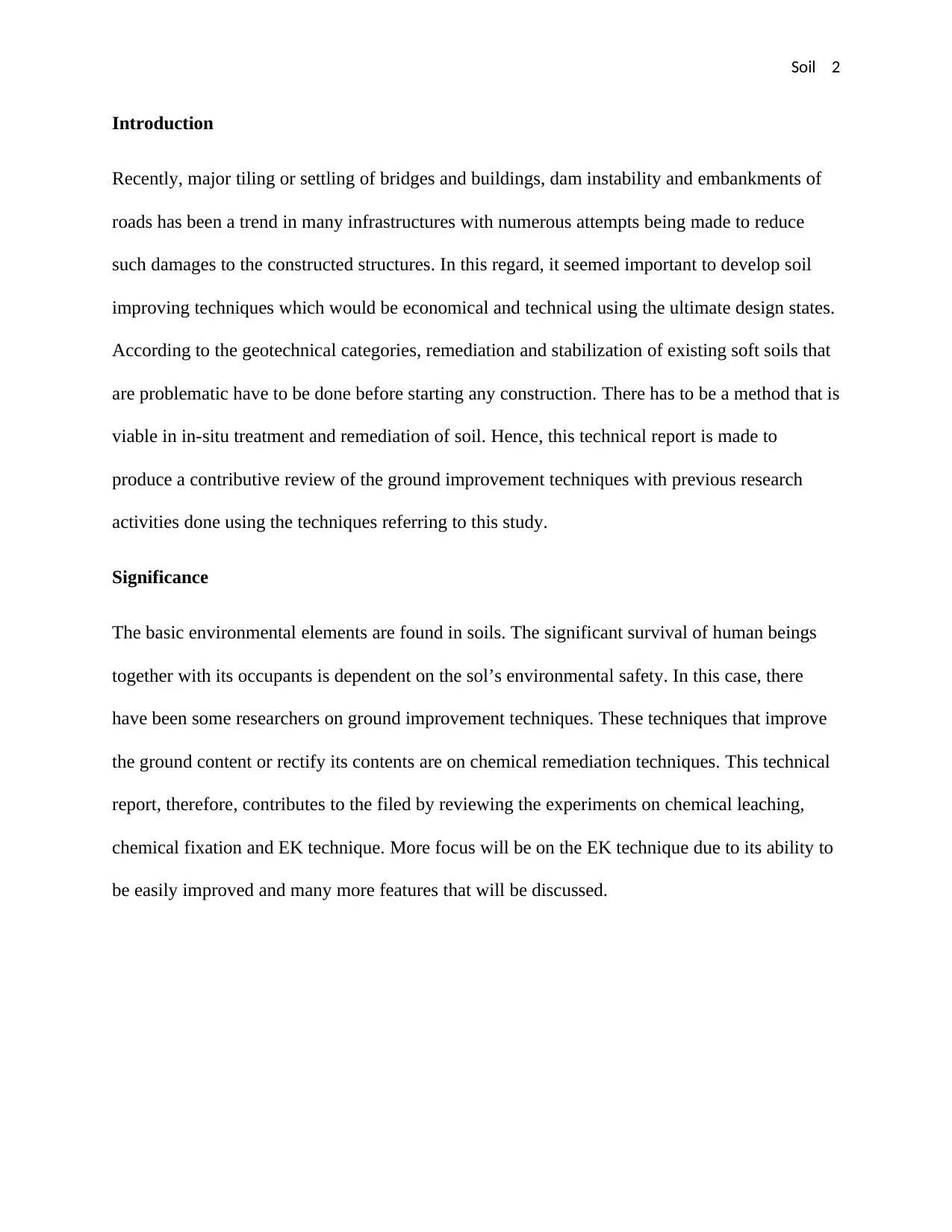
Soil 2
Introduction
Recently, major tiling or settling of bridges and buildings, dam instability and embankments of
roads has been a trend in many infrastructures with numerous attempts being made to reduce
such damages to the constructed structures. In this regard, it seemed important to develop soil
improving techniques which would be economical and technical using the ultimate design states.
According to the geotechnical categories, remediation and stabilization of existing soft soils that
are problematic have to be done before starting any construction. There has to be a method that is
viable in in-situ treatment and remediation of soil. Hence, this technical report is made to
produce a contributive review of the ground improvement techniques with previous research
activities done using the techniques referring to this study.
Significance
The basic environmental elements are found in soils. The significant survival of human beings
together with its occupants is dependent on the sol’s environmental safety. In this case, there
have been some researchers on ground improvement techniques. These techniques that improve
the ground content or rectify its contents are on chemical remediation techniques. This technical
report, therefore, contributes to the filed by reviewing the experiments on chemical leaching,
chemical fixation and EK technique. More focus will be on the EK technique due to its ability to
be easily improved and many more features that will be discussed.
Introduction
Recently, major tiling or settling of bridges and buildings, dam instability and embankments of
roads has been a trend in many infrastructures with numerous attempts being made to reduce
such damages to the constructed structures. In this regard, it seemed important to develop soil
improving techniques which would be economical and technical using the ultimate design states.
According to the geotechnical categories, remediation and stabilization of existing soft soils that
are problematic have to be done before starting any construction. There has to be a method that is
viable in in-situ treatment and remediation of soil. Hence, this technical report is made to
produce a contributive review of the ground improvement techniques with previous research
activities done using the techniques referring to this study.
Significance
The basic environmental elements are found in soils. The significant survival of human beings
together with its occupants is dependent on the sol’s environmental safety. In this case, there
have been some researchers on ground improvement techniques. These techniques that improve
the ground content or rectify its contents are on chemical remediation techniques. This technical
report, therefore, contributes to the filed by reviewing the experiments on chemical leaching,
chemical fixation and EK technique. More focus will be on the EK technique due to its ability to
be easily improved and many more features that will be discussed.
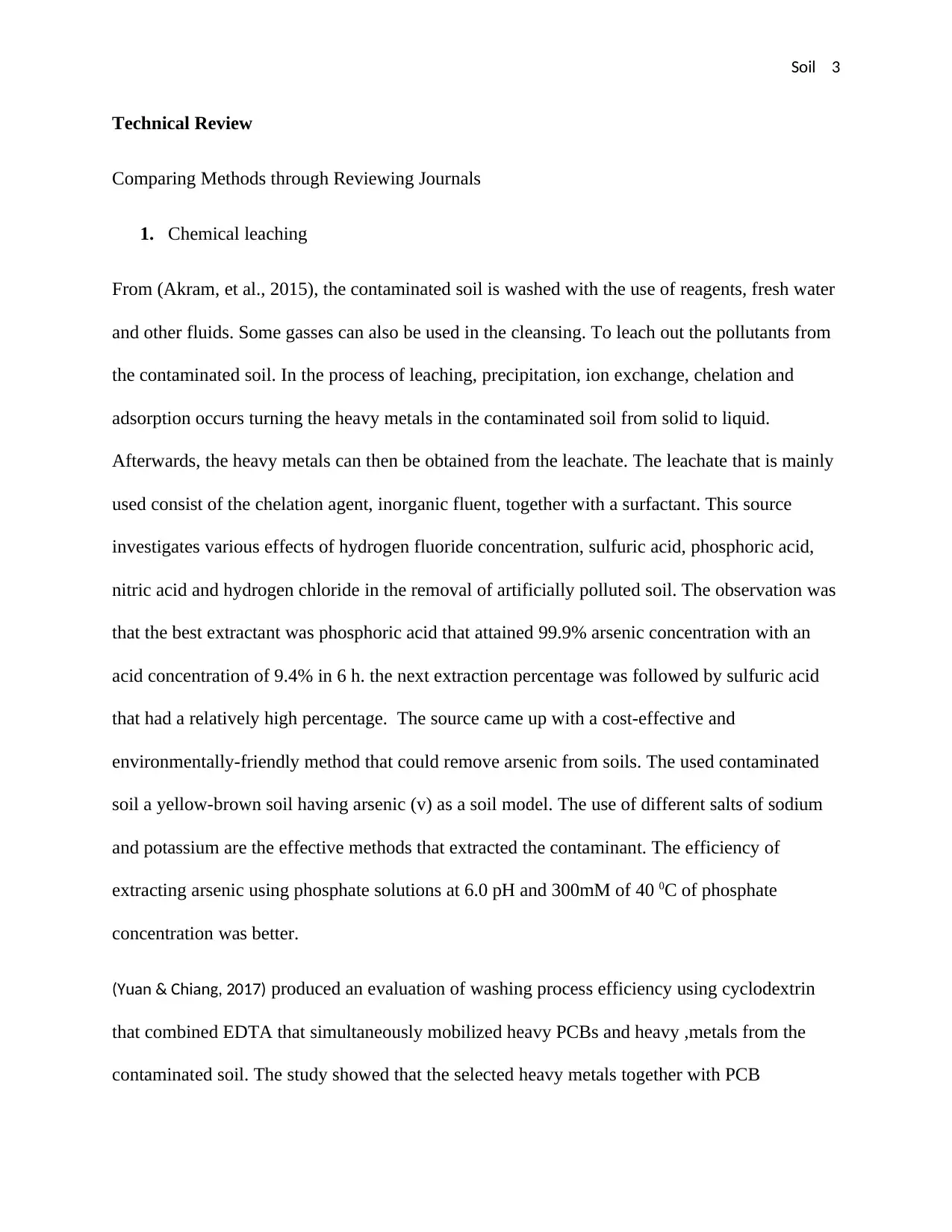
Soil 3
Technical Review
Comparing Methods through Reviewing Journals
1. Chemical leaching
From (Akram, et al., 2015), the contaminated soil is washed with the use of reagents, fresh water
and other fluids. Some gasses can also be used in the cleansing. To leach out the pollutants from
the contaminated soil. In the process of leaching, precipitation, ion exchange, chelation and
adsorption occurs turning the heavy metals in the contaminated soil from solid to liquid.
Afterwards, the heavy metals can then be obtained from the leachate. The leachate that is mainly
used consist of the chelation agent, inorganic fluent, together with a surfactant. This source
investigates various effects of hydrogen fluoride concentration, sulfuric acid, phosphoric acid,
nitric acid and hydrogen chloride in the removal of artificially polluted soil. The observation was
that the best extractant was phosphoric acid that attained 99.9% arsenic concentration with an
acid concentration of 9.4% in 6 h. the next extraction percentage was followed by sulfuric acid
that had a relatively high percentage. The source came up with a cost-effective and
environmentally-friendly method that could remove arsenic from soils. The used contaminated
soil a yellow-brown soil having arsenic (v) as a soil model. The use of different salts of sodium
and potassium are the effective methods that extracted the contaminant. The efficiency of
extracting arsenic using phosphate solutions at 6.0 pH and 300mM of 40 0C of phosphate
concentration was better.
(Yuan & Chiang, 2017) produced an evaluation of washing process efficiency using cyclodextrin
that combined EDTA that simultaneously mobilized heavy PCBs and heavy ,metals from the
contaminated soil. The study showed that the selected heavy metals together with PCB
Technical Review
Comparing Methods through Reviewing Journals
1. Chemical leaching
From (Akram, et al., 2015), the contaminated soil is washed with the use of reagents, fresh water
and other fluids. Some gasses can also be used in the cleansing. To leach out the pollutants from
the contaminated soil. In the process of leaching, precipitation, ion exchange, chelation and
adsorption occurs turning the heavy metals in the contaminated soil from solid to liquid.
Afterwards, the heavy metals can then be obtained from the leachate. The leachate that is mainly
used consist of the chelation agent, inorganic fluent, together with a surfactant. This source
investigates various effects of hydrogen fluoride concentration, sulfuric acid, phosphoric acid,
nitric acid and hydrogen chloride in the removal of artificially polluted soil. The observation was
that the best extractant was phosphoric acid that attained 99.9% arsenic concentration with an
acid concentration of 9.4% in 6 h. the next extraction percentage was followed by sulfuric acid
that had a relatively high percentage. The source came up with a cost-effective and
environmentally-friendly method that could remove arsenic from soils. The used contaminated
soil a yellow-brown soil having arsenic (v) as a soil model. The use of different salts of sodium
and potassium are the effective methods that extracted the contaminant. The efficiency of
extracting arsenic using phosphate solutions at 6.0 pH and 300mM of 40 0C of phosphate
concentration was better.
(Yuan & Chiang, 2017) produced an evaluation of washing process efficiency using cyclodextrin
that combined EDTA that simultaneously mobilized heavy PCBs and heavy ,metals from the
contaminated soil. The study showed that the selected heavy metals together with PCB
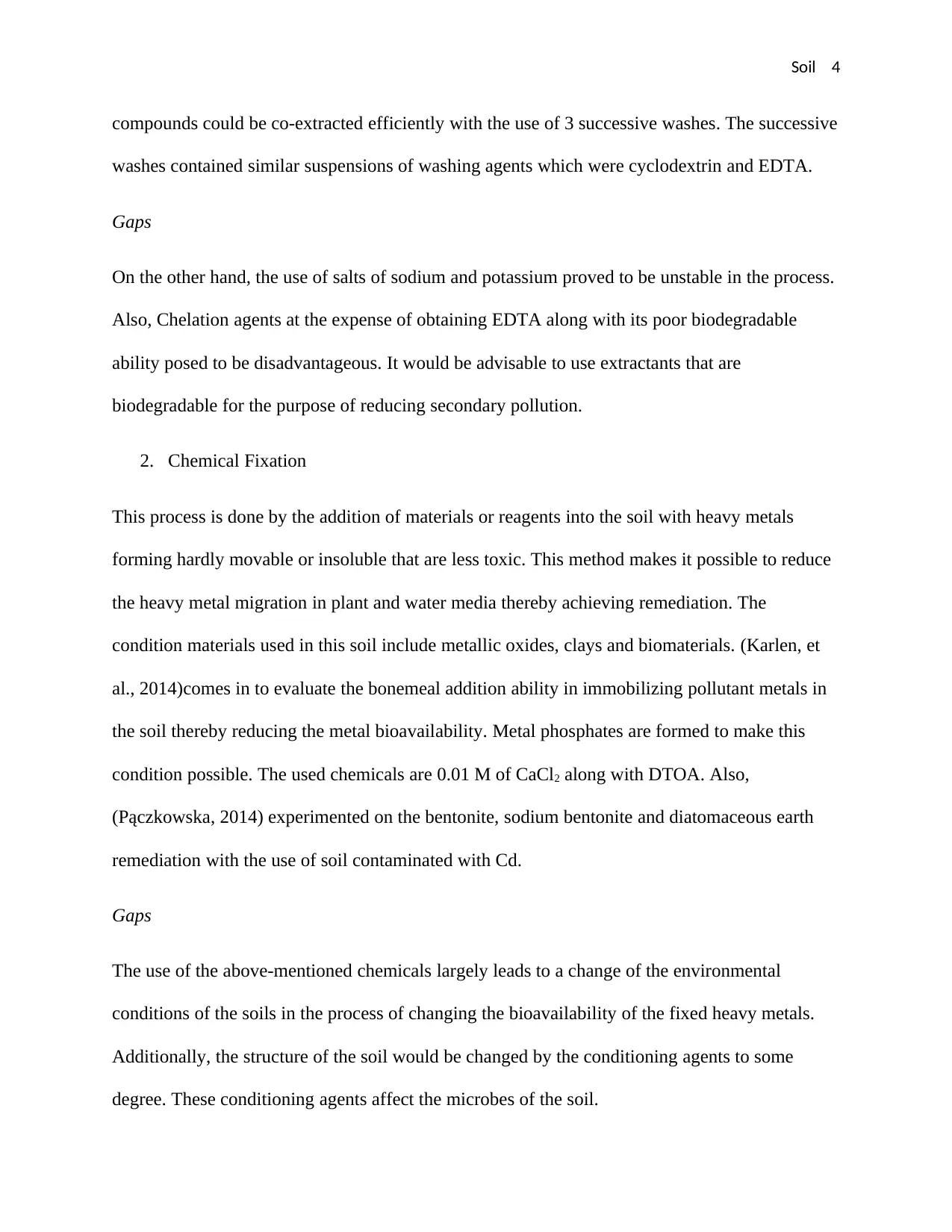
Soil 4
compounds could be co-extracted efficiently with the use of 3 successive washes. The successive
washes contained similar suspensions of washing agents which were cyclodextrin and EDTA.
Gaps
On the other hand, the use of salts of sodium and potassium proved to be unstable in the process.
Also, Chelation agents at the expense of obtaining EDTA along with its poor biodegradable
ability posed to be disadvantageous. It would be advisable to use extractants that are
biodegradable for the purpose of reducing secondary pollution.
2. Chemical Fixation
This process is done by the addition of materials or reagents into the soil with heavy metals
forming hardly movable or insoluble that are less toxic. This method makes it possible to reduce
the heavy metal migration in plant and water media thereby achieving remediation. The
condition materials used in this soil include metallic oxides, clays and biomaterials. (Karlen, et
al., 2014)comes in to evaluate the bonemeal addition ability in immobilizing pollutant metals in
the soil thereby reducing the metal bioavailability. Metal phosphates are formed to make this
condition possible. The used chemicals are 0.01 M of CaCl2 along with DTOA. Also,
(Pączkowska, 2014) experimented on the bentonite, sodium bentonite and diatomaceous earth
remediation with the use of soil contaminated with Cd.
Gaps
The use of the above-mentioned chemicals largely leads to a change of the environmental
conditions of the soils in the process of changing the bioavailability of the fixed heavy metals.
Additionally, the structure of the soil would be changed by the conditioning agents to some
degree. These conditioning agents affect the microbes of the soil.
compounds could be co-extracted efficiently with the use of 3 successive washes. The successive
washes contained similar suspensions of washing agents which were cyclodextrin and EDTA.
Gaps
On the other hand, the use of salts of sodium and potassium proved to be unstable in the process.
Also, Chelation agents at the expense of obtaining EDTA along with its poor biodegradable
ability posed to be disadvantageous. It would be advisable to use extractants that are
biodegradable for the purpose of reducing secondary pollution.
2. Chemical Fixation
This process is done by the addition of materials or reagents into the soil with heavy metals
forming hardly movable or insoluble that are less toxic. This method makes it possible to reduce
the heavy metal migration in plant and water media thereby achieving remediation. The
condition materials used in this soil include metallic oxides, clays and biomaterials. (Karlen, et
al., 2014)comes in to evaluate the bonemeal addition ability in immobilizing pollutant metals in
the soil thereby reducing the metal bioavailability. Metal phosphates are formed to make this
condition possible. The used chemicals are 0.01 M of CaCl2 along with DTOA. Also,
(Pączkowska, 2014) experimented on the bentonite, sodium bentonite and diatomaceous earth
remediation with the use of soil contaminated with Cd.
Gaps
The use of the above-mentioned chemicals largely leads to a change of the environmental
conditions of the soils in the process of changing the bioavailability of the fixed heavy metals.
Additionally, the structure of the soil would be changed by the conditioning agents to some
degree. These conditioning agents affect the microbes of the soil.
Secure Best Marks with AI Grader
Need help grading? Try our AI Grader for instant feedback on your assignments.
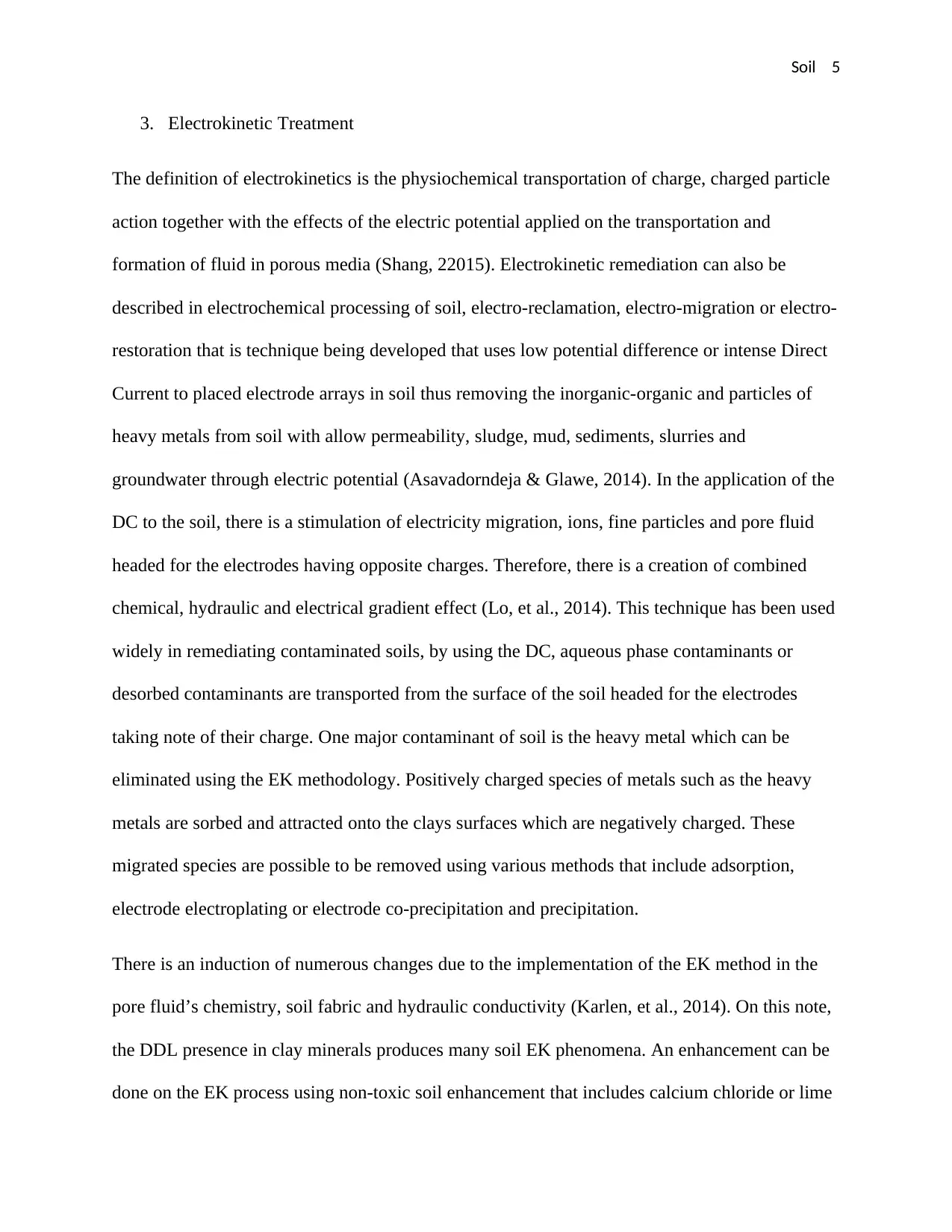
Soil 5
3. Electrokinetic Treatment
The definition of electrokinetics is the physiochemical transportation of charge, charged particle
action together with the effects of the electric potential applied on the transportation and
formation of fluid in porous media (Shang, 22015). Electrokinetic remediation can also be
described in electrochemical processing of soil, electro-reclamation, electro-migration or electro-
restoration that is technique being developed that uses low potential difference or intense Direct
Current to placed electrode arrays in soil thus removing the inorganic-organic and particles of
heavy metals from soil with allow permeability, sludge, mud, sediments, slurries and
groundwater through electric potential (Asavadorndeja & Glawe, 2014). In the application of the
DC to the soil, there is a stimulation of electricity migration, ions, fine particles and pore fluid
headed for the electrodes having opposite charges. Therefore, there is a creation of combined
chemical, hydraulic and electrical gradient effect (Lo, et al., 2014). This technique has been used
widely in remediating contaminated soils, by using the DC, aqueous phase contaminants or
desorbed contaminants are transported from the surface of the soil headed for the electrodes
taking note of their charge. One major contaminant of soil is the heavy metal which can be
eliminated using the EK methodology. Positively charged species of metals such as the heavy
metals are sorbed and attracted onto the clays surfaces which are negatively charged. These
migrated species are possible to be removed using various methods that include adsorption,
electrode electroplating or electrode co-precipitation and precipitation.
There is an induction of numerous changes due to the implementation of the EK method in the
pore fluid’s chemistry, soil fabric and hydraulic conductivity (Karlen, et al., 2014). On this note,
the DDL presence in clay minerals produces many soil EK phenomena. An enhancement can be
done on the EK process using non-toxic soil enhancement that includes calcium chloride or lime
3. Electrokinetic Treatment
The definition of electrokinetics is the physiochemical transportation of charge, charged particle
action together with the effects of the electric potential applied on the transportation and
formation of fluid in porous media (Shang, 22015). Electrokinetic remediation can also be
described in electrochemical processing of soil, electro-reclamation, electro-migration or electro-
restoration that is technique being developed that uses low potential difference or intense Direct
Current to placed electrode arrays in soil thus removing the inorganic-organic and particles of
heavy metals from soil with allow permeability, sludge, mud, sediments, slurries and
groundwater through electric potential (Asavadorndeja & Glawe, 2014). In the application of the
DC to the soil, there is a stimulation of electricity migration, ions, fine particles and pore fluid
headed for the electrodes having opposite charges. Therefore, there is a creation of combined
chemical, hydraulic and electrical gradient effect (Lo, et al., 2014). This technique has been used
widely in remediating contaminated soils, by using the DC, aqueous phase contaminants or
desorbed contaminants are transported from the surface of the soil headed for the electrodes
taking note of their charge. One major contaminant of soil is the heavy metal which can be
eliminated using the EK methodology. Positively charged species of metals such as the heavy
metals are sorbed and attracted onto the clays surfaces which are negatively charged. These
migrated species are possible to be removed using various methods that include adsorption,
electrode electroplating or electrode co-precipitation and precipitation.
There is an induction of numerous changes due to the implementation of the EK method in the
pore fluid’s chemistry, soil fabric and hydraulic conductivity (Karlen, et al., 2014). On this note,
the DDL presence in clay minerals produces many soil EK phenomena. An enhancement can be
done on the EK process using non-toxic soil enhancement that includes calcium chloride or lime
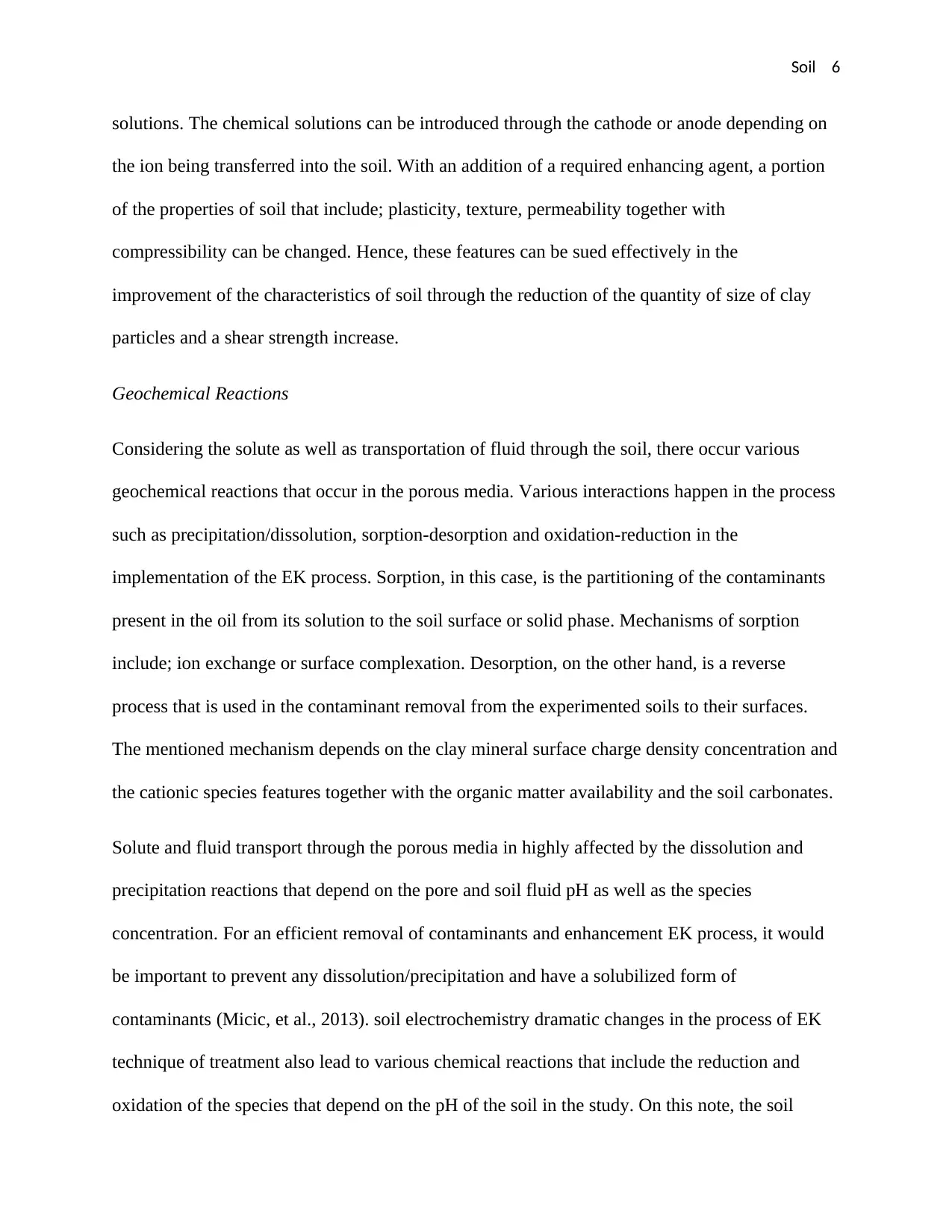
Soil 6
solutions. The chemical solutions can be introduced through the cathode or anode depending on
the ion being transferred into the soil. With an addition of a required enhancing agent, a portion
of the properties of soil that include; plasticity, texture, permeability together with
compressibility can be changed. Hence, these features can be sued effectively in the
improvement of the characteristics of soil through the reduction of the quantity of size of clay
particles and a shear strength increase.
Geochemical Reactions
Considering the solute as well as transportation of fluid through the soil, there occur various
geochemical reactions that occur in the porous media. Various interactions happen in the process
such as precipitation/dissolution, sorption-desorption and oxidation-reduction in the
implementation of the EK process. Sorption, in this case, is the partitioning of the contaminants
present in the oil from its solution to the soil surface or solid phase. Mechanisms of sorption
include; ion exchange or surface complexation. Desorption, on the other hand, is a reverse
process that is used in the contaminant removal from the experimented soils to their surfaces.
The mentioned mechanism depends on the clay mineral surface charge density concentration and
the cationic species features together with the organic matter availability and the soil carbonates.
Solute and fluid transport through the porous media in highly affected by the dissolution and
precipitation reactions that depend on the pore and soil fluid pH as well as the species
concentration. For an efficient removal of contaminants and enhancement EK process, it would
be important to prevent any dissolution/precipitation and have a solubilized form of
contaminants (Micic, et al., 2013). soil electrochemistry dramatic changes in the process of EK
technique of treatment also lead to various chemical reactions that include the reduction and
oxidation of the species that depend on the pH of the soil in the study. On this note, the soil
solutions. The chemical solutions can be introduced through the cathode or anode depending on
the ion being transferred into the soil. With an addition of a required enhancing agent, a portion
of the properties of soil that include; plasticity, texture, permeability together with
compressibility can be changed. Hence, these features can be sued effectively in the
improvement of the characteristics of soil through the reduction of the quantity of size of clay
particles and a shear strength increase.
Geochemical Reactions
Considering the solute as well as transportation of fluid through the soil, there occur various
geochemical reactions that occur in the porous media. Various interactions happen in the process
such as precipitation/dissolution, sorption-desorption and oxidation-reduction in the
implementation of the EK process. Sorption, in this case, is the partitioning of the contaminants
present in the oil from its solution to the soil surface or solid phase. Mechanisms of sorption
include; ion exchange or surface complexation. Desorption, on the other hand, is a reverse
process that is used in the contaminant removal from the experimented soils to their surfaces.
The mentioned mechanism depends on the clay mineral surface charge density concentration and
the cationic species features together with the organic matter availability and the soil carbonates.
Solute and fluid transport through the porous media in highly affected by the dissolution and
precipitation reactions that depend on the pore and soil fluid pH as well as the species
concentration. For an efficient removal of contaminants and enhancement EK process, it would
be important to prevent any dissolution/precipitation and have a solubilized form of
contaminants (Micic, et al., 2013). soil electrochemistry dramatic changes in the process of EK
technique of treatment also lead to various chemical reactions that include the reduction and
oxidation of the species that depend on the pH of the soil in the study. On this note, the soil
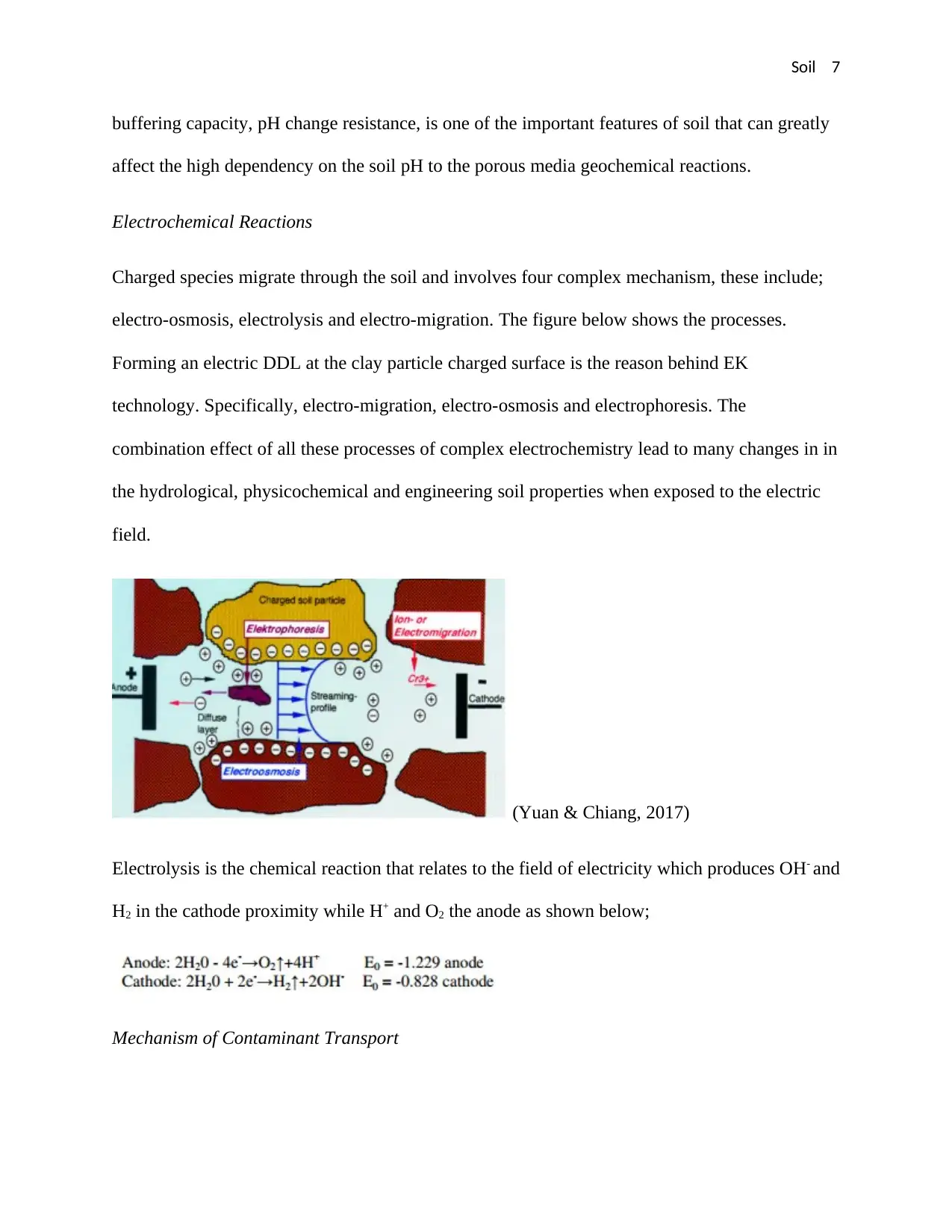
Soil 7
buffering capacity, pH change resistance, is one of the important features of soil that can greatly
affect the high dependency on the soil pH to the porous media geochemical reactions.
Electrochemical Reactions
Charged species migrate through the soil and involves four complex mechanism, these include;
electro-osmosis, electrolysis and electro-migration. The figure below shows the processes.
Forming an electric DDL at the clay particle charged surface is the reason behind EK
technology. Specifically, electro-migration, electro-osmosis and electrophoresis. The
combination effect of all these processes of complex electrochemistry lead to many changes in in
the hydrological, physicochemical and engineering soil properties when exposed to the electric
field.
(Yuan & Chiang, 2017)
Electrolysis is the chemical reaction that relates to the field of electricity which produces OH- and
H2 in the cathode proximity while H+ and O2 the anode as shown below;
Mechanism of Contaminant Transport
buffering capacity, pH change resistance, is one of the important features of soil that can greatly
affect the high dependency on the soil pH to the porous media geochemical reactions.
Electrochemical Reactions
Charged species migrate through the soil and involves four complex mechanism, these include;
electro-osmosis, electrolysis and electro-migration. The figure below shows the processes.
Forming an electric DDL at the clay particle charged surface is the reason behind EK
technology. Specifically, electro-migration, electro-osmosis and electrophoresis. The
combination effect of all these processes of complex electrochemistry lead to many changes in in
the hydrological, physicochemical and engineering soil properties when exposed to the electric
field.
(Yuan & Chiang, 2017)
Electrolysis is the chemical reaction that relates to the field of electricity which produces OH- and
H2 in the cathode proximity while H+ and O2 the anode as shown below;
Mechanism of Contaminant Transport
Paraphrase This Document
Need a fresh take? Get an instant paraphrase of this document with our AI Paraphraser
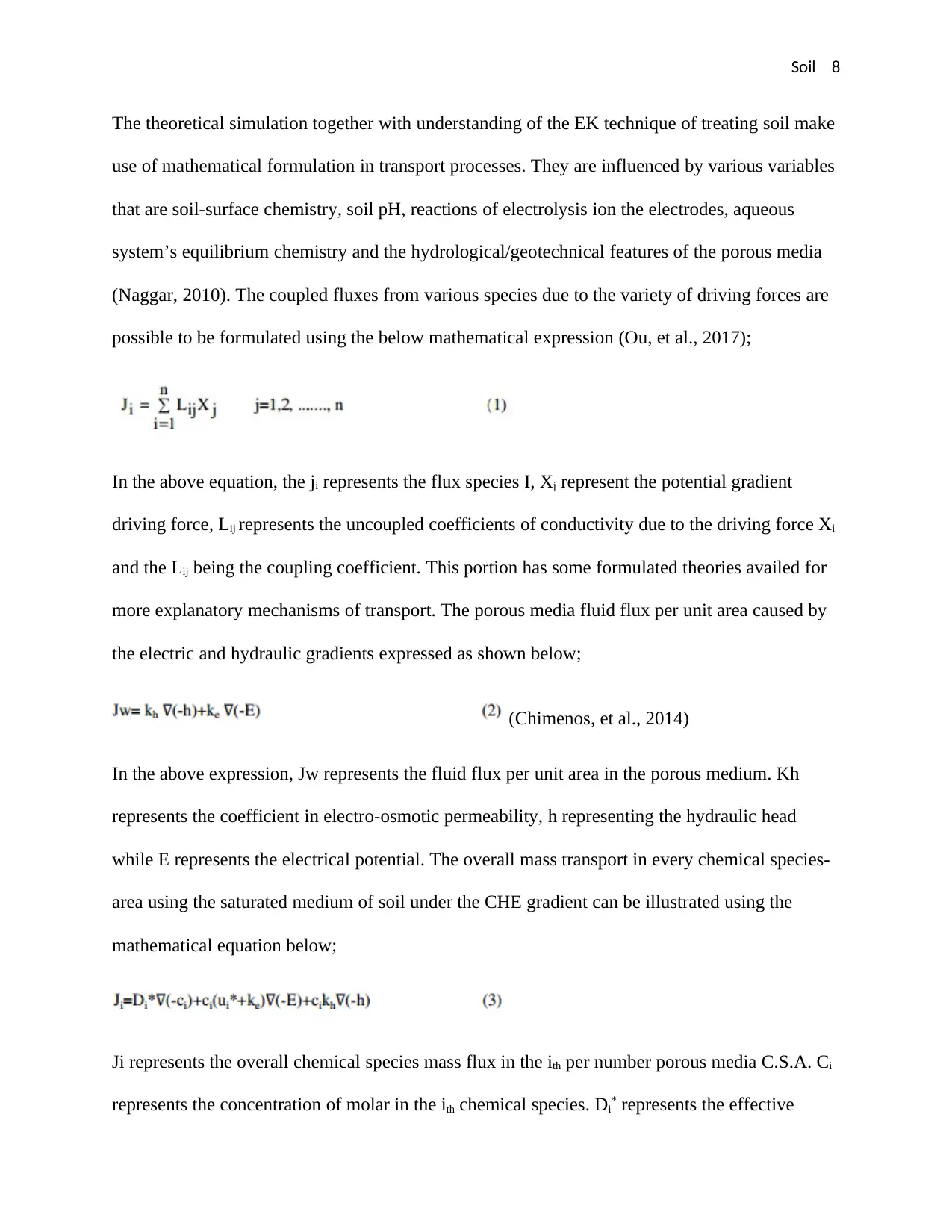
Soil 8
The theoretical simulation together with understanding of the EK technique of treating soil make
use of mathematical formulation in transport processes. They are influenced by various variables
that are soil-surface chemistry, soil pH, reactions of electrolysis ion the electrodes, aqueous
system’s equilibrium chemistry and the hydrological/geotechnical features of the porous media
(Naggar, 2010). The coupled fluxes from various species due to the variety of driving forces are
possible to be formulated using the below mathematical expression (Ou, et al., 2017);
In the above equation, the ji represents the flux species I, Xj represent the potential gradient
driving force, Lij represents the uncoupled coefficients of conductivity due to the driving force Xi
and the Lij being the coupling coefficient. This portion has some formulated theories availed for
more explanatory mechanisms of transport. The porous media fluid flux per unit area caused by
the electric and hydraulic gradients expressed as shown below;
(Chimenos, et al., 2014)
In the above expression, Jw represents the fluid flux per unit area in the porous medium. Kh
represents the coefficient in electro-osmotic permeability, h representing the hydraulic head
while E represents the electrical potential. The overall mass transport in every chemical species-
area using the saturated medium of soil under the CHE gradient can be illustrated using the
mathematical equation below;
Ji represents the overall chemical species mass flux in the ith per number porous media C.S.A. Ci
represents the concentration of molar in the ith chemical species. Di* represents the effective
The theoretical simulation together with understanding of the EK technique of treating soil make
use of mathematical formulation in transport processes. They are influenced by various variables
that are soil-surface chemistry, soil pH, reactions of electrolysis ion the electrodes, aqueous
system’s equilibrium chemistry and the hydrological/geotechnical features of the porous media
(Naggar, 2010). The coupled fluxes from various species due to the variety of driving forces are
possible to be formulated using the below mathematical expression (Ou, et al., 2017);
In the above equation, the ji represents the flux species I, Xj represent the potential gradient
driving force, Lij represents the uncoupled coefficients of conductivity due to the driving force Xi
and the Lij being the coupling coefficient. This portion has some formulated theories availed for
more explanatory mechanisms of transport. The porous media fluid flux per unit area caused by
the electric and hydraulic gradients expressed as shown below;
(Chimenos, et al., 2014)
In the above expression, Jw represents the fluid flux per unit area in the porous medium. Kh
represents the coefficient in electro-osmotic permeability, h representing the hydraulic head
while E represents the electrical potential. The overall mass transport in every chemical species-
area using the saturated medium of soil under the CHE gradient can be illustrated using the
mathematical equation below;
Ji represents the overall chemical species mass flux in the ith per number porous media C.S.A. Ci
represents the concentration of molar in the ith chemical species. Di* represents the effective
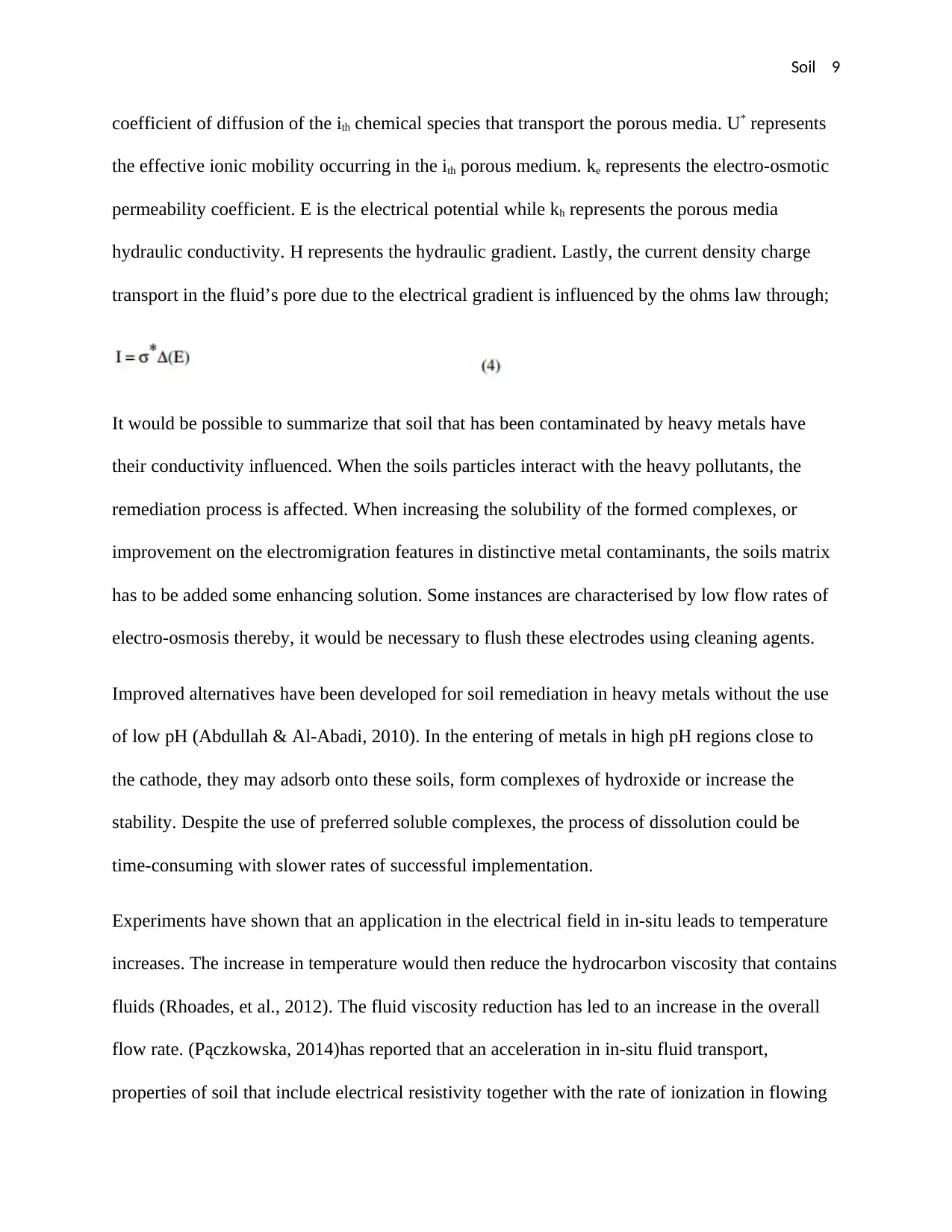
Soil 9
coefficient of diffusion of the ith chemical species that transport the porous media. U* represents
the effective ionic mobility occurring in the ith porous medium. ke represents the electro-osmotic
permeability coefficient. E is the electrical potential while kh represents the porous media
hydraulic conductivity. H represents the hydraulic gradient. Lastly, the current density charge
transport in the fluid’s pore due to the electrical gradient is influenced by the ohms law through;
It would be possible to summarize that soil that has been contaminated by heavy metals have
their conductivity influenced. When the soils particles interact with the heavy pollutants, the
remediation process is affected. When increasing the solubility of the formed complexes, or
improvement on the electromigration features in distinctive metal contaminants, the soils matrix
has to be added some enhancing solution. Some instances are characterised by low flow rates of
electro-osmosis thereby, it would be necessary to flush these electrodes using cleaning agents.
Improved alternatives have been developed for soil remediation in heavy metals without the use
of low pH (Abdullah & Al-Abadi, 2010). In the entering of metals in high pH regions close to
the cathode, they may adsorb onto these soils, form complexes of hydroxide or increase the
stability. Despite the use of preferred soluble complexes, the process of dissolution could be
time-consuming with slower rates of successful implementation.
Experiments have shown that an application in the electrical field in in-situ leads to temperature
increases. The increase in temperature would then reduce the hydrocarbon viscosity that contains
fluids (Rhoades, et al., 2012). The fluid viscosity reduction has led to an increase in the overall
flow rate. (Pączkowska, 2014)has reported that an acceleration in in-situ fluid transport,
properties of soil that include electrical resistivity together with the rate of ionization in flowing
coefficient of diffusion of the ith chemical species that transport the porous media. U* represents
the effective ionic mobility occurring in the ith porous medium. ke represents the electro-osmotic
permeability coefficient. E is the electrical potential while kh represents the porous media
hydraulic conductivity. H represents the hydraulic gradient. Lastly, the current density charge
transport in the fluid’s pore due to the electrical gradient is influenced by the ohms law through;
It would be possible to summarize that soil that has been contaminated by heavy metals have
their conductivity influenced. When the soils particles interact with the heavy pollutants, the
remediation process is affected. When increasing the solubility of the formed complexes, or
improvement on the electromigration features in distinctive metal contaminants, the soils matrix
has to be added some enhancing solution. Some instances are characterised by low flow rates of
electro-osmosis thereby, it would be necessary to flush these electrodes using cleaning agents.
Improved alternatives have been developed for soil remediation in heavy metals without the use
of low pH (Abdullah & Al-Abadi, 2010). In the entering of metals in high pH regions close to
the cathode, they may adsorb onto these soils, form complexes of hydroxide or increase the
stability. Despite the use of preferred soluble complexes, the process of dissolution could be
time-consuming with slower rates of successful implementation.
Experiments have shown that an application in the electrical field in in-situ leads to temperature
increases. The increase in temperature would then reduce the hydrocarbon viscosity that contains
fluids (Rhoades, et al., 2012). The fluid viscosity reduction has led to an increase in the overall
flow rate. (Pączkowska, 2014)has reported that an acceleration in in-situ fluid transport,
properties of soil that include electrical resistivity together with the rate of ionization in flowing
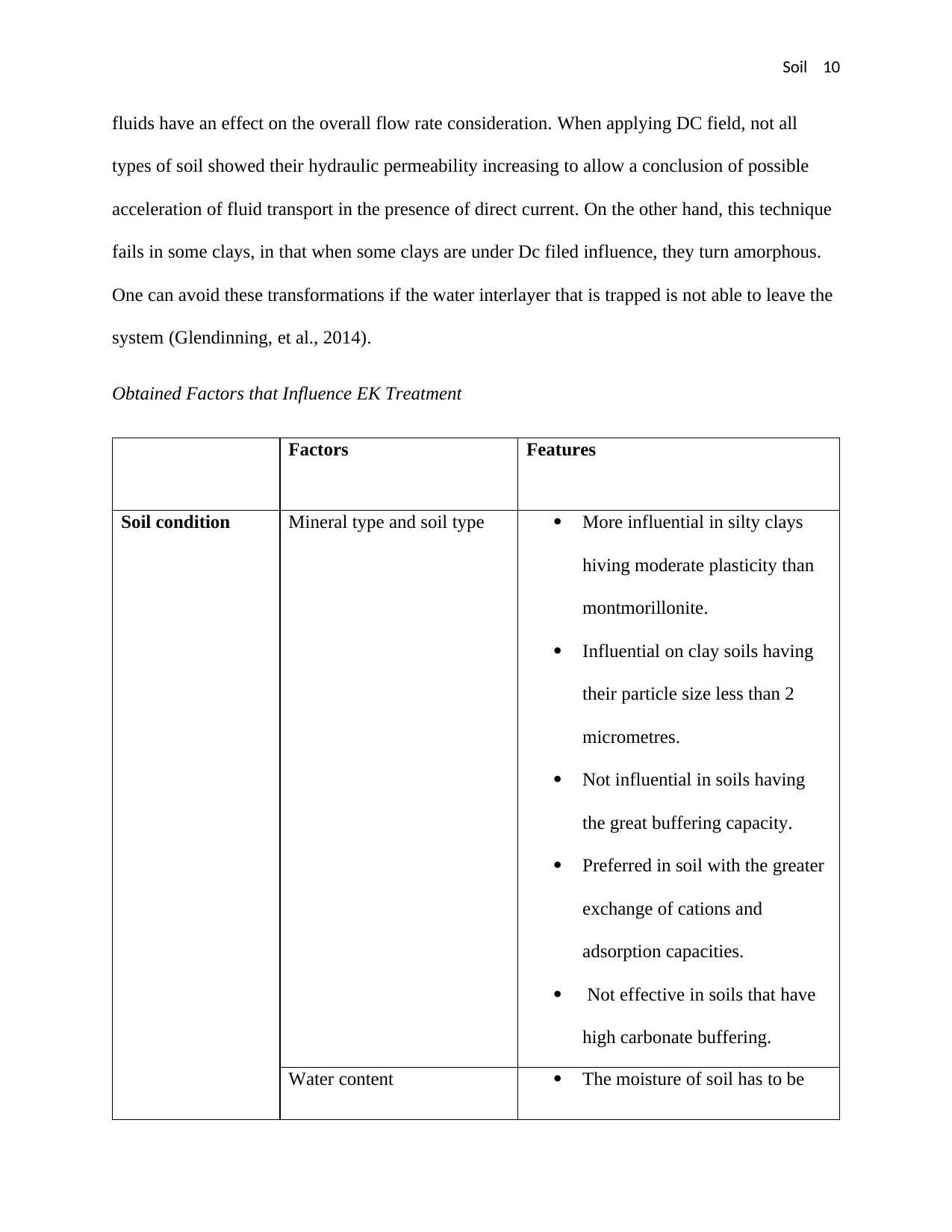
Soil 10
fluids have an effect on the overall flow rate consideration. When applying DC field, not all
types of soil showed their hydraulic permeability increasing to allow a conclusion of possible
acceleration of fluid transport in the presence of direct current. On the other hand, this technique
fails in some clays, in that when some clays are under Dc filed influence, they turn amorphous.
One can avoid these transformations if the water interlayer that is trapped is not able to leave the
system (Glendinning, et al., 2014).
Obtained Factors that Influence EK Treatment
Factors Features
Soil condition Mineral type and soil type More influential in silty clays
hiving moderate plasticity than
montmorillonite.
Influential on clay soils having
their particle size less than 2
micrometres.
Not influential in soils having
the great buffering capacity.
Preferred in soil with the greater
exchange of cations and
adsorption capacities.
Not effective in soils that have
high carbonate buffering.
Water content The moisture of soil has to be
fluids have an effect on the overall flow rate consideration. When applying DC field, not all
types of soil showed their hydraulic permeability increasing to allow a conclusion of possible
acceleration of fluid transport in the presence of direct current. On the other hand, this technique
fails in some clays, in that when some clays are under Dc filed influence, they turn amorphous.
One can avoid these transformations if the water interlayer that is trapped is not able to leave the
system (Glendinning, et al., 2014).
Obtained Factors that Influence EK Treatment
Factors Features
Soil condition Mineral type and soil type More influential in silty clays
hiving moderate plasticity than
montmorillonite.
Influential on clay soils having
their particle size less than 2
micrometres.
Not influential in soils having
the great buffering capacity.
Preferred in soil with the greater
exchange of cations and
adsorption capacities.
Not effective in soils that have
high carbonate buffering.
Water content The moisture of soil has to be
Secure Best Marks with AI Grader
Need help grading? Try our AI Grader for instant feedback on your assignments.
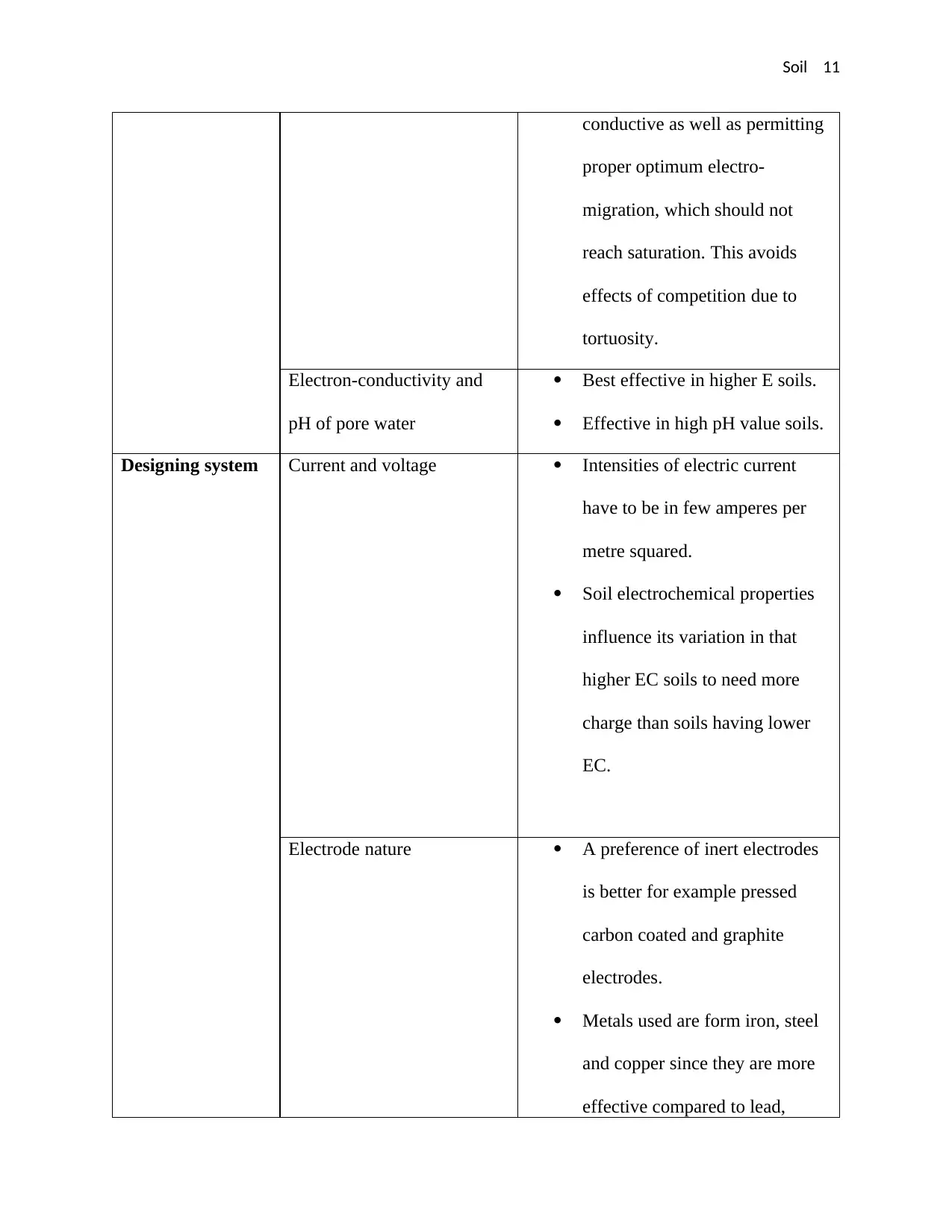
Soil 11
conductive as well as permitting
proper optimum electro-
migration, which should not
reach saturation. This avoids
effects of competition due to
tortuosity.
Electron-conductivity and
pH of pore water
Best effective in higher E soils.
Effective in high pH value soils.
Designing system Current and voltage Intensities of electric current
have to be in few amperes per
metre squared.
Soil electrochemical properties
influence its variation in that
higher EC soils to need more
charge than soils having lower
EC.
Electrode nature A preference of inert electrodes
is better for example pressed
carbon coated and graphite
electrodes.
Metals used are form iron, steel
and copper since they are more
effective compared to lead,
conductive as well as permitting
proper optimum electro-
migration, which should not
reach saturation. This avoids
effects of competition due to
tortuosity.
Electron-conductivity and
pH of pore water
Best effective in higher E soils.
Effective in high pH value soils.
Designing system Current and voltage Intensities of electric current
have to be in few amperes per
metre squared.
Soil electrochemical properties
influence its variation in that
higher EC soils to need more
charge than soils having lower
EC.
Electrode nature A preference of inert electrodes
is better for example pressed
carbon coated and graphite
electrodes.
Metals used are form iron, steel
and copper since they are more
effective compared to lead,
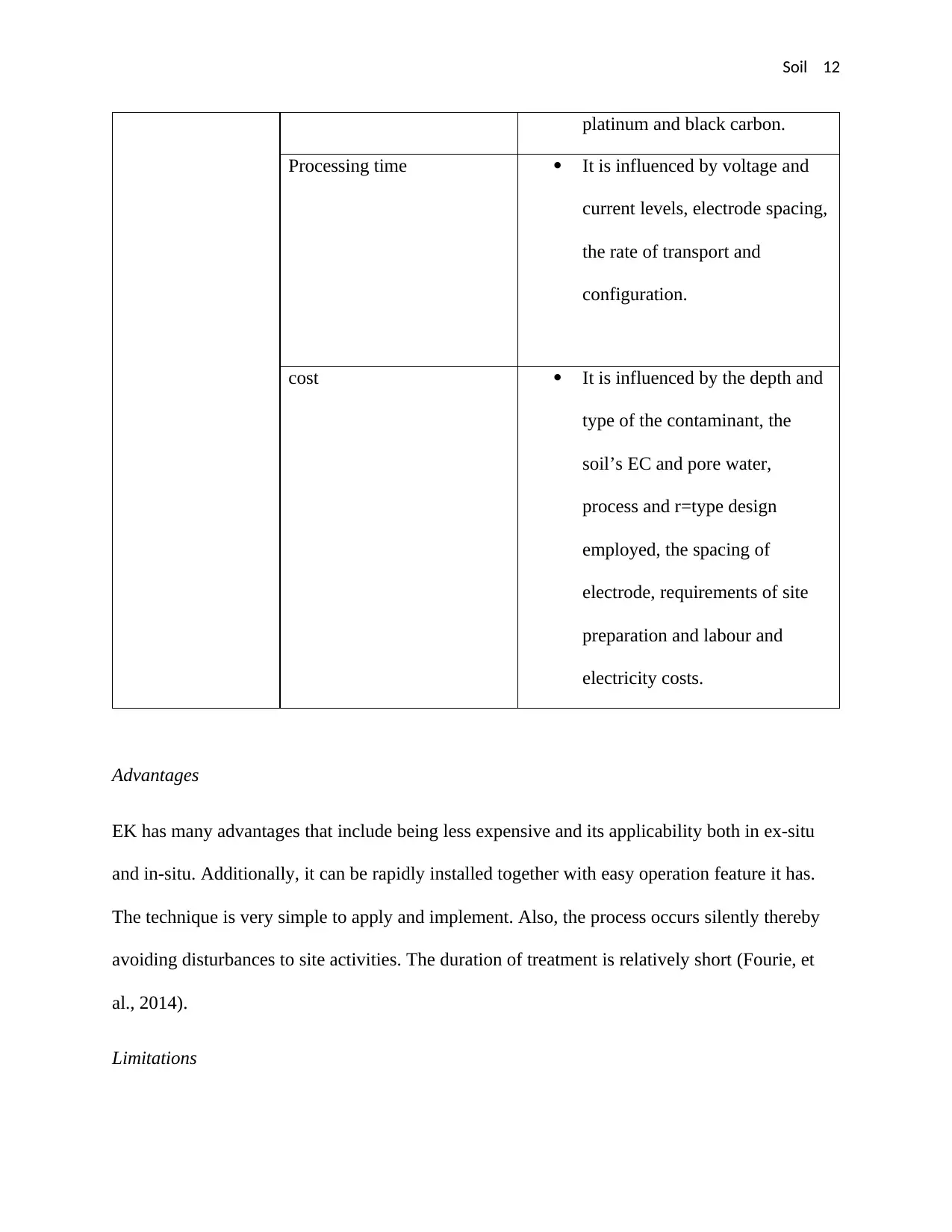
Soil 12
platinum and black carbon.
Processing time It is influenced by voltage and
current levels, electrode spacing,
the rate of transport and
configuration.
cost It is influenced by the depth and
type of the contaminant, the
soil’s EC and pore water,
process and r=type design
employed, the spacing of
electrode, requirements of site
preparation and labour and
electricity costs.
Advantages
EK has many advantages that include being less expensive and its applicability both in ex-situ
and in-situ. Additionally, it can be rapidly installed together with easy operation feature it has.
The technique is very simple to apply and implement. Also, the process occurs silently thereby
avoiding disturbances to site activities. The duration of treatment is relatively short (Fourie, et
al., 2014).
Limitations
platinum and black carbon.
Processing time It is influenced by voltage and
current levels, electrode spacing,
the rate of transport and
configuration.
cost It is influenced by the depth and
type of the contaminant, the
soil’s EC and pore water,
process and r=type design
employed, the spacing of
electrode, requirements of site
preparation and labour and
electricity costs.
Advantages
EK has many advantages that include being less expensive and its applicability both in ex-situ
and in-situ. Additionally, it can be rapidly installed together with easy operation feature it has.
The technique is very simple to apply and implement. Also, the process occurs silently thereby
avoiding disturbances to site activities. The duration of treatment is relatively short (Fourie, et
al., 2014).
Limitations
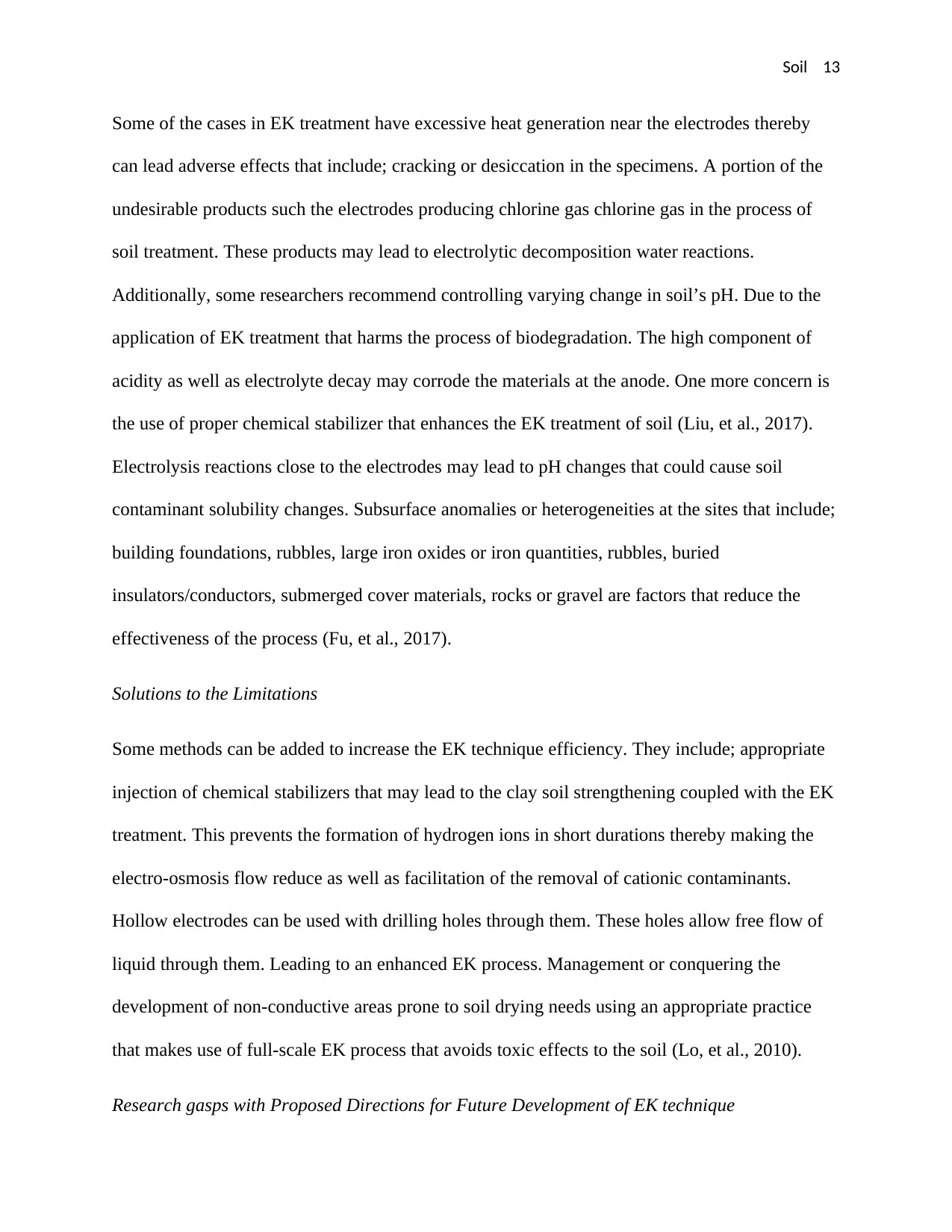
Soil 13
Some of the cases in EK treatment have excessive heat generation near the electrodes thereby
can lead adverse effects that include; cracking or desiccation in the specimens. A portion of the
undesirable products such the electrodes producing chlorine gas chlorine gas in the process of
soil treatment. These products may lead to electrolytic decomposition water reactions.
Additionally, some researchers recommend controlling varying change in soil’s pH. Due to the
application of EK treatment that harms the process of biodegradation. The high component of
acidity as well as electrolyte decay may corrode the materials at the anode. One more concern is
the use of proper chemical stabilizer that enhances the EK treatment of soil (Liu, et al., 2017).
Electrolysis reactions close to the electrodes may lead to pH changes that could cause soil
contaminant solubility changes. Subsurface anomalies or heterogeneities at the sites that include;
building foundations, rubbles, large iron oxides or iron quantities, rubbles, buried
insulators/conductors, submerged cover materials, rocks or gravel are factors that reduce the
effectiveness of the process (Fu, et al., 2017).
Solutions to the Limitations
Some methods can be added to increase the EK technique efficiency. They include; appropriate
injection of chemical stabilizers that may lead to the clay soil strengthening coupled with the EK
treatment. This prevents the formation of hydrogen ions in short durations thereby making the
electro-osmosis flow reduce as well as facilitation of the removal of cationic contaminants.
Hollow electrodes can be used with drilling holes through them. These holes allow free flow of
liquid through them. Leading to an enhanced EK process. Management or conquering the
development of non-conductive areas prone to soil drying needs using an appropriate practice
that makes use of full-scale EK process that avoids toxic effects to the soil (Lo, et al., 2010).
Research gasps with Proposed Directions for Future Development of EK technique
Some of the cases in EK treatment have excessive heat generation near the electrodes thereby
can lead adverse effects that include; cracking or desiccation in the specimens. A portion of the
undesirable products such the electrodes producing chlorine gas chlorine gas in the process of
soil treatment. These products may lead to electrolytic decomposition water reactions.
Additionally, some researchers recommend controlling varying change in soil’s pH. Due to the
application of EK treatment that harms the process of biodegradation. The high component of
acidity as well as electrolyte decay may corrode the materials at the anode. One more concern is
the use of proper chemical stabilizer that enhances the EK treatment of soil (Liu, et al., 2017).
Electrolysis reactions close to the electrodes may lead to pH changes that could cause soil
contaminant solubility changes. Subsurface anomalies or heterogeneities at the sites that include;
building foundations, rubbles, large iron oxides or iron quantities, rubbles, buried
insulators/conductors, submerged cover materials, rocks or gravel are factors that reduce the
effectiveness of the process (Fu, et al., 2017).
Solutions to the Limitations
Some methods can be added to increase the EK technique efficiency. They include; appropriate
injection of chemical stabilizers that may lead to the clay soil strengthening coupled with the EK
treatment. This prevents the formation of hydrogen ions in short durations thereby making the
electro-osmosis flow reduce as well as facilitation of the removal of cationic contaminants.
Hollow electrodes can be used with drilling holes through them. These holes allow free flow of
liquid through them. Leading to an enhanced EK process. Management or conquering the
development of non-conductive areas prone to soil drying needs using an appropriate practice
that makes use of full-scale EK process that avoids toxic effects to the soil (Lo, et al., 2010).
Research gasps with Proposed Directions for Future Development of EK technique
Paraphrase This Document
Need a fresh take? Get an instant paraphrase of this document with our AI Paraphraser
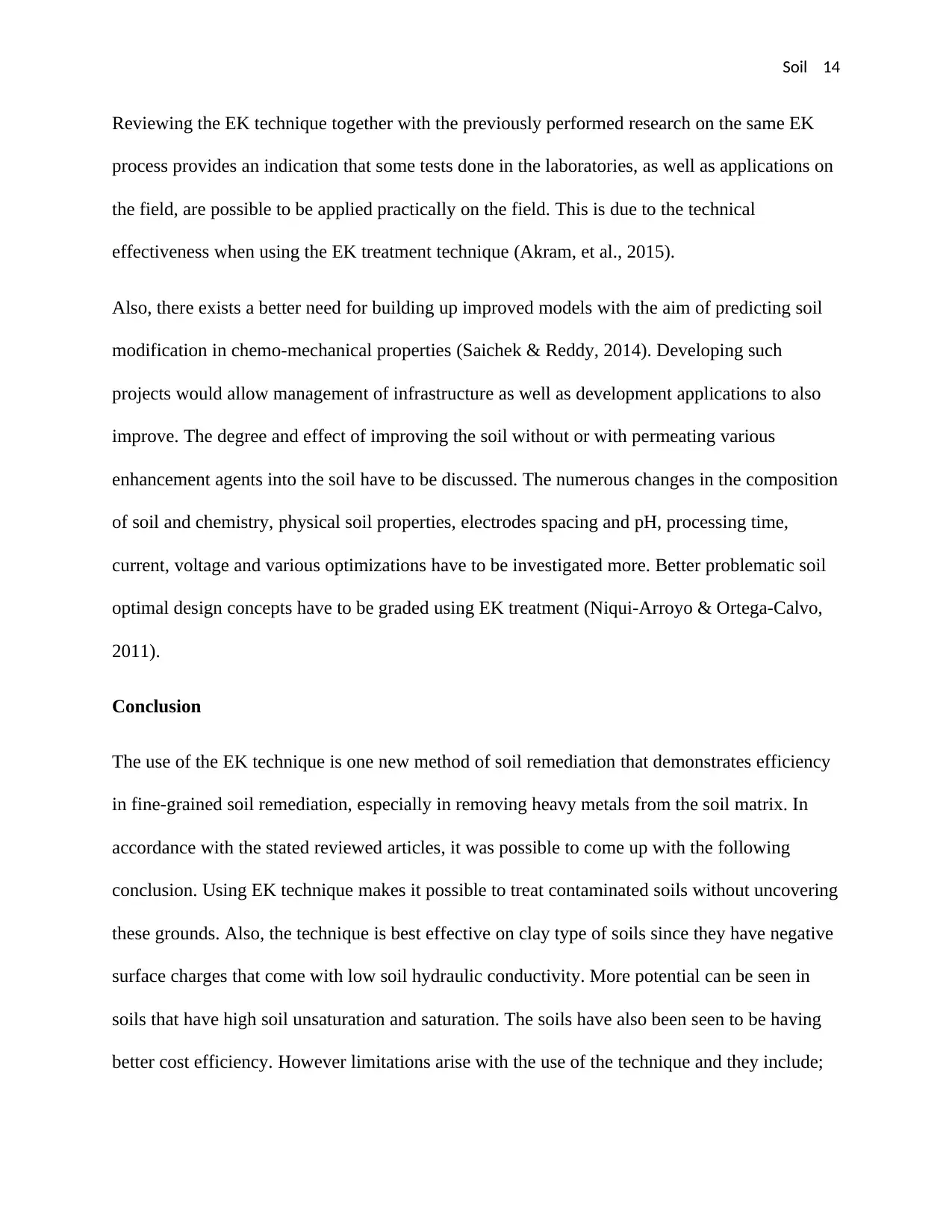
Soil 14
Reviewing the EK technique together with the previously performed research on the same EK
process provides an indication that some tests done in the laboratories, as well as applications on
the field, are possible to be applied practically on the field. This is due to the technical
effectiveness when using the EK treatment technique (Akram, et al., 2015).
Also, there exists a better need for building up improved models with the aim of predicting soil
modification in chemo-mechanical properties (Saichek & Reddy, 2014). Developing such
projects would allow management of infrastructure as well as development applications to also
improve. The degree and effect of improving the soil without or with permeating various
enhancement agents into the soil have to be discussed. The numerous changes in the composition
of soil and chemistry, physical soil properties, electrodes spacing and pH, processing time,
current, voltage and various optimizations have to be investigated more. Better problematic soil
optimal design concepts have to be graded using EK treatment (Niqui-Arroyo & Ortega-Calvo,
2011).
Conclusion
The use of the EK technique is one new method of soil remediation that demonstrates efficiency
in fine-grained soil remediation, especially in removing heavy metals from the soil matrix. In
accordance with the stated reviewed articles, it was possible to come up with the following
conclusion. Using EK technique makes it possible to treat contaminated soils without uncovering
these grounds. Also, the technique is best effective on clay type of soils since they have negative
surface charges that come with low soil hydraulic conductivity. More potential can be seen in
soils that have high soil unsaturation and saturation. The soils have also been seen to be having
better cost efficiency. However limitations arise with the use of the technique and they include;
Reviewing the EK technique together with the previously performed research on the same EK
process provides an indication that some tests done in the laboratories, as well as applications on
the field, are possible to be applied practically on the field. This is due to the technical
effectiveness when using the EK treatment technique (Akram, et al., 2015).
Also, there exists a better need for building up improved models with the aim of predicting soil
modification in chemo-mechanical properties (Saichek & Reddy, 2014). Developing such
projects would allow management of infrastructure as well as development applications to also
improve. The degree and effect of improving the soil without or with permeating various
enhancement agents into the soil have to be discussed. The numerous changes in the composition
of soil and chemistry, physical soil properties, electrodes spacing and pH, processing time,
current, voltage and various optimizations have to be investigated more. Better problematic soil
optimal design concepts have to be graded using EK treatment (Niqui-Arroyo & Ortega-Calvo,
2011).
Conclusion
The use of the EK technique is one new method of soil remediation that demonstrates efficiency
in fine-grained soil remediation, especially in removing heavy metals from the soil matrix. In
accordance with the stated reviewed articles, it was possible to come up with the following
conclusion. Using EK technique makes it possible to treat contaminated soils without uncovering
these grounds. Also, the technique is best effective on clay type of soils since they have negative
surface charges that come with low soil hydraulic conductivity. More potential can be seen in
soils that have high soil unsaturation and saturation. The soils have also been seen to be having
better cost efficiency. However limitations arise with the use of the technique and they include;

Soil 15
the necessity to using enhancing solutions, the contaminant being highly dependable on the pH
of the soil and soil containing hematite and carbonates reduce the efficiency of the technique.
the necessity to using enhancing solutions, the contaminant being highly dependable on the pH
of the soil and soil containing hematite and carbonates reduce the efficiency of the technique.
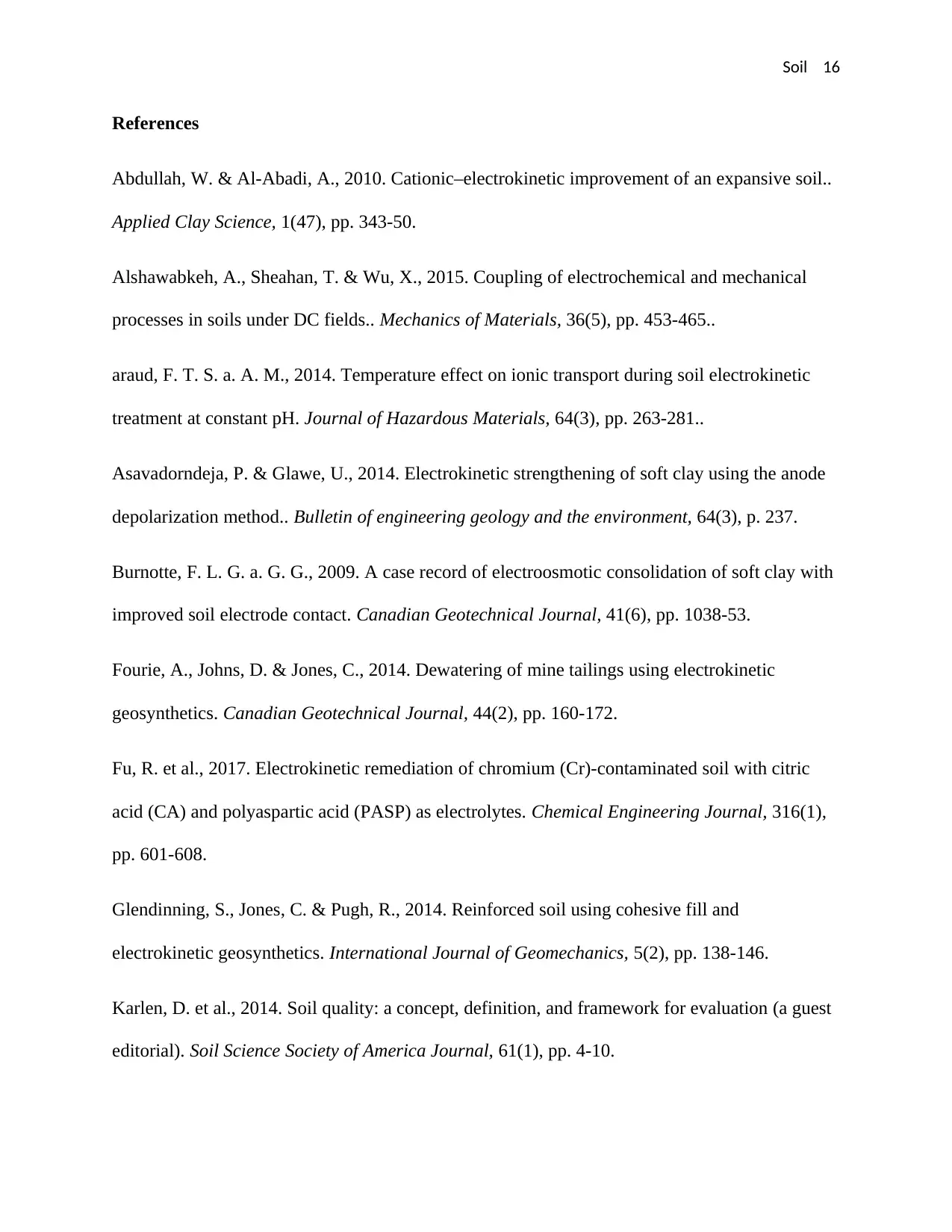
Soil 16
References
Abdullah, W. & Al-Abadi, A., 2010. Cationic–electrokinetic improvement of an expansive soil..
Applied Clay Science, 1(47), pp. 343-50.
Alshawabkeh, A., Sheahan, T. & Wu, X., 2015. Coupling of electrochemical and mechanical
processes in soils under DC fields.. Mechanics of Materials, 36(5), pp. 453-465..
araud, F. T. S. a. A. M., 2014. Temperature effect on ionic transport during soil electrokinetic
treatment at constant pH. Journal of Hazardous Materials, 64(3), pp. 263-281..
Asavadorndeja, P. & Glawe, U., 2014. Electrokinetic strengthening of soft clay using the anode
depolarization method.. Bulletin of engineering geology and the environment, 64(3), p. 237.
Burnotte, F. L. G. a. G. G., 2009. A case record of electroosmotic consolidation of soft clay with
improved soil electrode contact. Canadian Geotechnical Journal, 41(6), pp. 1038-53.
Fourie, A., Johns, D. & Jones, C., 2014. Dewatering of mine tailings using electrokinetic
geosynthetics. Canadian Geotechnical Journal, 44(2), pp. 160-172.
Fu, R. et al., 2017. Electrokinetic remediation of chromium (Cr)-contaminated soil with citric
acid (CA) and polyaspartic acid (PASP) as electrolytes. Chemical Engineering Journal, 316(1),
pp. 601-608.
Glendinning, S., Jones, C. & Pugh, R., 2014. Reinforced soil using cohesive fill and
electrokinetic geosynthetics. International Journal of Geomechanics, 5(2), pp. 138-146.
Karlen, D. et al., 2014. Soil quality: a concept, definition, and framework for evaluation (a guest
editorial). Soil Science Society of America Journal, 61(1), pp. 4-10.
References
Abdullah, W. & Al-Abadi, A., 2010. Cationic–electrokinetic improvement of an expansive soil..
Applied Clay Science, 1(47), pp. 343-50.
Alshawabkeh, A., Sheahan, T. & Wu, X., 2015. Coupling of electrochemical and mechanical
processes in soils under DC fields.. Mechanics of Materials, 36(5), pp. 453-465..
araud, F. T. S. a. A. M., 2014. Temperature effect on ionic transport during soil electrokinetic
treatment at constant pH. Journal of Hazardous Materials, 64(3), pp. 263-281..
Asavadorndeja, P. & Glawe, U., 2014. Electrokinetic strengthening of soft clay using the anode
depolarization method.. Bulletin of engineering geology and the environment, 64(3), p. 237.
Burnotte, F. L. G. a. G. G., 2009. A case record of electroosmotic consolidation of soft clay with
improved soil electrode contact. Canadian Geotechnical Journal, 41(6), pp. 1038-53.
Fourie, A., Johns, D. & Jones, C., 2014. Dewatering of mine tailings using electrokinetic
geosynthetics. Canadian Geotechnical Journal, 44(2), pp. 160-172.
Fu, R. et al., 2017. Electrokinetic remediation of chromium (Cr)-contaminated soil with citric
acid (CA) and polyaspartic acid (PASP) as electrolytes. Chemical Engineering Journal, 316(1),
pp. 601-608.
Glendinning, S., Jones, C. & Pugh, R., 2014. Reinforced soil using cohesive fill and
electrokinetic geosynthetics. International Journal of Geomechanics, 5(2), pp. 138-146.
Karlen, D. et al., 2014. Soil quality: a concept, definition, and framework for evaluation (a guest
editorial). Soil Science Society of America Journal, 61(1), pp. 4-10.
Secure Best Marks with AI Grader
Need help grading? Try our AI Grader for instant feedback on your assignments.
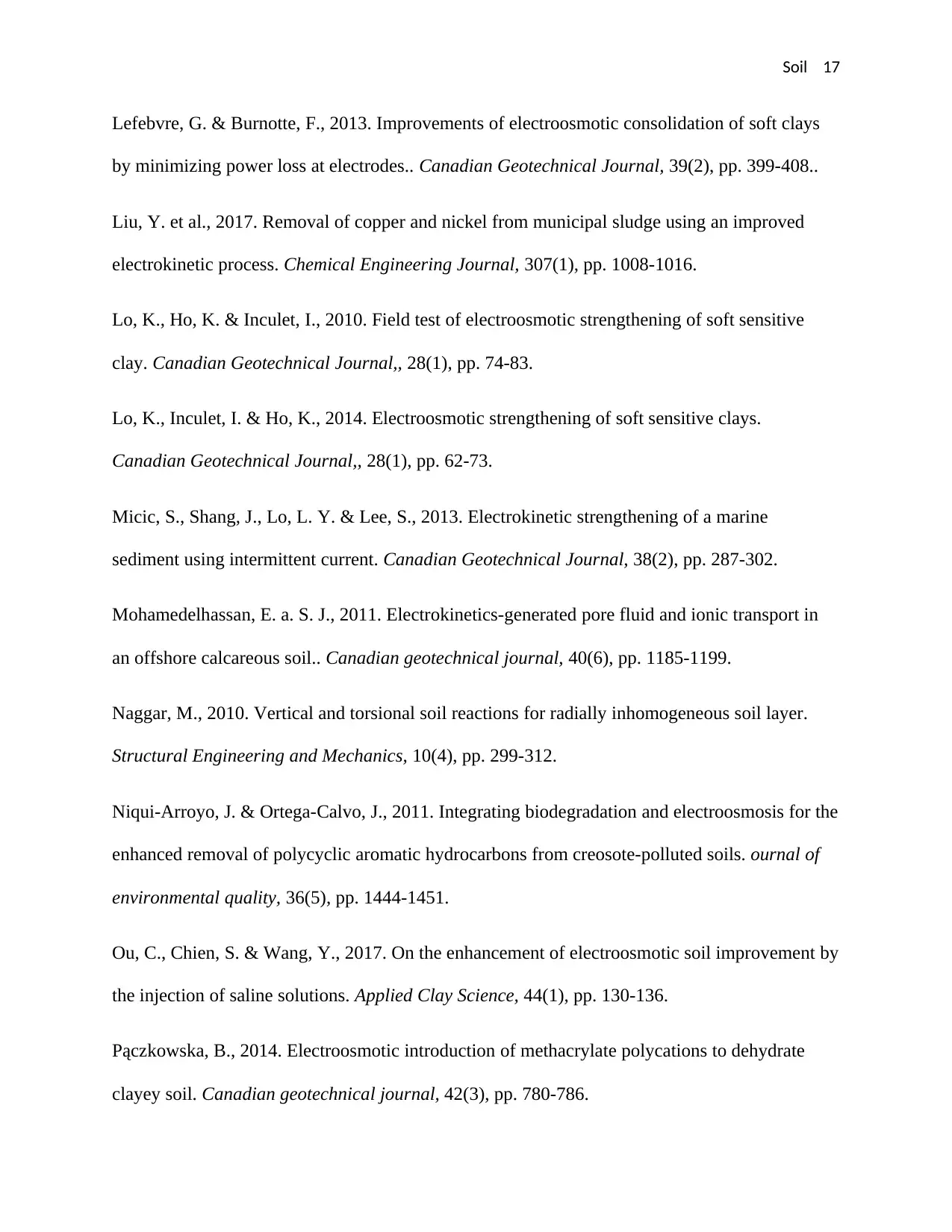
Soil 17
Lefebvre, G. & Burnotte, F., 2013. Improvements of electroosmotic consolidation of soft clays
by minimizing power loss at electrodes.. Canadian Geotechnical Journal, 39(2), pp. 399-408..
Liu, Y. et al., 2017. Removal of copper and nickel from municipal sludge using an improved
electrokinetic process. Chemical Engineering Journal, 307(1), pp. 1008-1016.
Lo, K., Ho, K. & Inculet, I., 2010. Field test of electroosmotic strengthening of soft sensitive
clay. Canadian Geotechnical Journal,, 28(1), pp. 74-83.
Lo, K., Inculet, I. & Ho, K., 2014. Electroosmotic strengthening of soft sensitive clays.
Canadian Geotechnical Journal,, 28(1), pp. 62-73.
Micic, S., Shang, J., Lo, L. Y. & Lee, S., 2013. Electrokinetic strengthening of a marine
sediment using intermittent current. Canadian Geotechnical Journal, 38(2), pp. 287-302.
Mohamedelhassan, E. a. S. J., 2011. Electrokinetics-generated pore fluid and ionic transport in
an offshore calcareous soil.. Canadian geotechnical journal, 40(6), pp. 1185-1199.
Naggar, M., 2010. Vertical and torsional soil reactions for radially inhomogeneous soil layer.
Structural Engineering and Mechanics, 10(4), pp. 299-312.
Niqui-Arroyo, J. & Ortega-Calvo, J., 2011. Integrating biodegradation and electroosmosis for the
enhanced removal of polycyclic aromatic hydrocarbons from creosote-polluted soils. ournal of
environmental quality, 36(5), pp. 1444-1451.
Ou, C., Chien, S. & Wang, Y., 2017. On the enhancement of electroosmotic soil improvement by
the injection of saline solutions. Applied Clay Science, 44(1), pp. 130-136.
Pączkowska, B., 2014. Electroosmotic introduction of methacrylate polycations to dehydrate
clayey soil. Canadian geotechnical journal, 42(3), pp. 780-786.
Lefebvre, G. & Burnotte, F., 2013. Improvements of electroosmotic consolidation of soft clays
by minimizing power loss at electrodes.. Canadian Geotechnical Journal, 39(2), pp. 399-408..
Liu, Y. et al., 2017. Removal of copper and nickel from municipal sludge using an improved
electrokinetic process. Chemical Engineering Journal, 307(1), pp. 1008-1016.
Lo, K., Ho, K. & Inculet, I., 2010. Field test of electroosmotic strengthening of soft sensitive
clay. Canadian Geotechnical Journal,, 28(1), pp. 74-83.
Lo, K., Inculet, I. & Ho, K., 2014. Electroosmotic strengthening of soft sensitive clays.
Canadian Geotechnical Journal,, 28(1), pp. 62-73.
Micic, S., Shang, J., Lo, L. Y. & Lee, S., 2013. Electrokinetic strengthening of a marine
sediment using intermittent current. Canadian Geotechnical Journal, 38(2), pp. 287-302.
Mohamedelhassan, E. a. S. J., 2011. Electrokinetics-generated pore fluid and ionic transport in
an offshore calcareous soil.. Canadian geotechnical journal, 40(6), pp. 1185-1199.
Naggar, M., 2010. Vertical and torsional soil reactions for radially inhomogeneous soil layer.
Structural Engineering and Mechanics, 10(4), pp. 299-312.
Niqui-Arroyo, J. & Ortega-Calvo, J., 2011. Integrating biodegradation and electroosmosis for the
enhanced removal of polycyclic aromatic hydrocarbons from creosote-polluted soils. ournal of
environmental quality, 36(5), pp. 1444-1451.
Ou, C., Chien, S. & Wang, Y., 2017. On the enhancement of electroosmotic soil improvement by
the injection of saline solutions. Applied Clay Science, 44(1), pp. 130-136.
Pączkowska, B., 2014. Electroosmotic introduction of methacrylate polycations to dehydrate
clayey soil. Canadian geotechnical journal, 42(3), pp. 780-786.
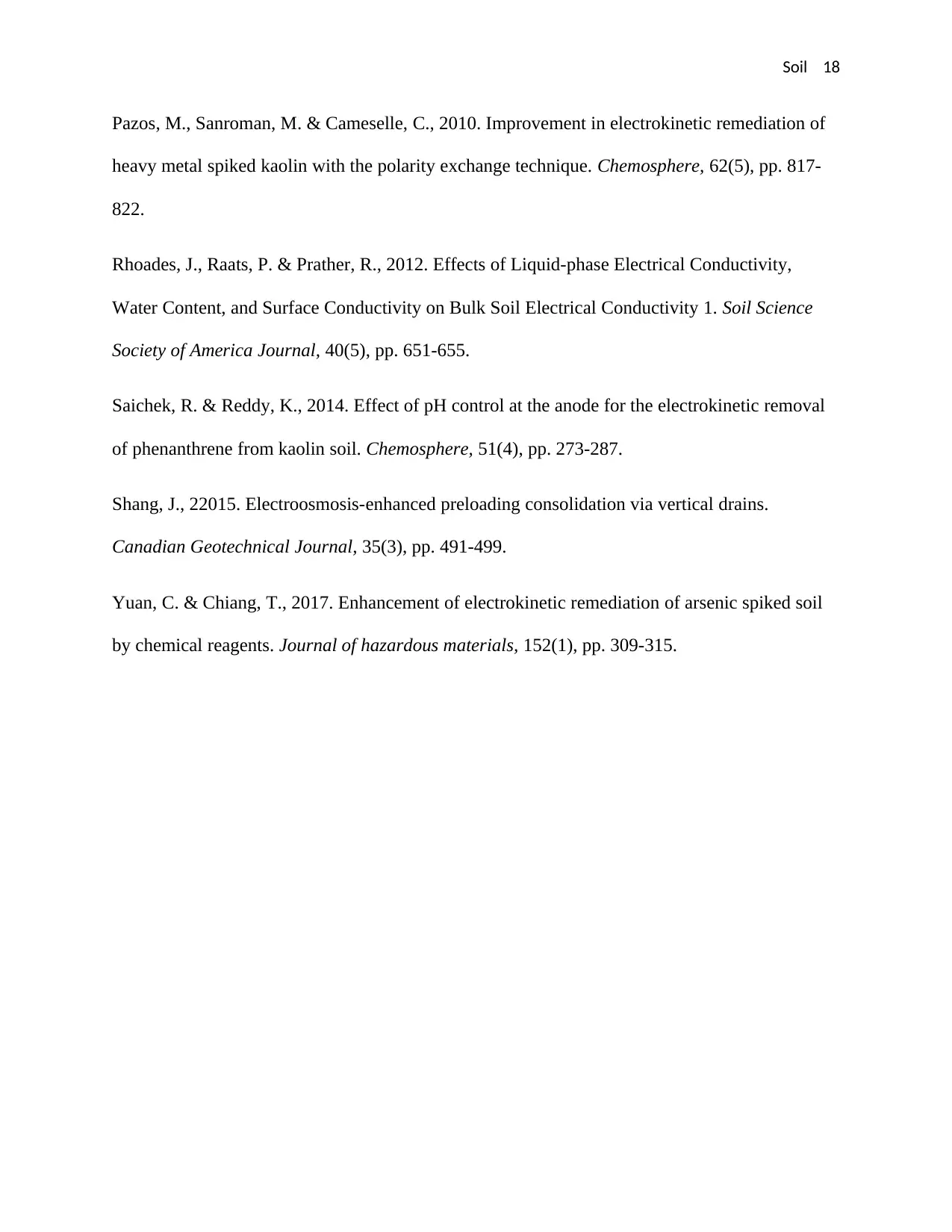
Soil 18
Pazos, M., Sanroman, M. & Cameselle, C., 2010. Improvement in electrokinetic remediation of
heavy metal spiked kaolin with the polarity exchange technique. Chemosphere, 62(5), pp. 817-
822.
Rhoades, J., Raats, P. & Prather, R., 2012. Effects of Liquid-phase Electrical Conductivity,
Water Content, and Surface Conductivity on Bulk Soil Electrical Conductivity 1. Soil Science
Society of America Journal, 40(5), pp. 651-655.
Saichek, R. & Reddy, K., 2014. Effect of pH control at the anode for the electrokinetic removal
of phenanthrene from kaolin soil. Chemosphere, 51(4), pp. 273-287.
Shang, J., 22015. Electroosmosis-enhanced preloading consolidation via vertical drains.
Canadian Geotechnical Journal, 35(3), pp. 491-499.
Yuan, C. & Chiang, T., 2017. Enhancement of electrokinetic remediation of arsenic spiked soil
by chemical reagents. Journal of hazardous materials, 152(1), pp. 309-315.
Pazos, M., Sanroman, M. & Cameselle, C., 2010. Improvement in electrokinetic remediation of
heavy metal spiked kaolin with the polarity exchange technique. Chemosphere, 62(5), pp. 817-
822.
Rhoades, J., Raats, P. & Prather, R., 2012. Effects of Liquid-phase Electrical Conductivity,
Water Content, and Surface Conductivity on Bulk Soil Electrical Conductivity 1. Soil Science
Society of America Journal, 40(5), pp. 651-655.
Saichek, R. & Reddy, K., 2014. Effect of pH control at the anode for the electrokinetic removal
of phenanthrene from kaolin soil. Chemosphere, 51(4), pp. 273-287.
Shang, J., 22015. Electroosmosis-enhanced preloading consolidation via vertical drains.
Canadian Geotechnical Journal, 35(3), pp. 491-499.
Yuan, C. & Chiang, T., 2017. Enhancement of electrokinetic remediation of arsenic spiked soil
by chemical reagents. Journal of hazardous materials, 152(1), pp. 309-315.
1 out of 18
Your All-in-One AI-Powered Toolkit for Academic Success.
+13062052269
info@desklib.com
Available 24*7 on WhatsApp / Email
![[object Object]](/_next/static/media/star-bottom.7253800d.svg)
Unlock your academic potential
© 2024 | Zucol Services PVT LTD | All rights reserved.
